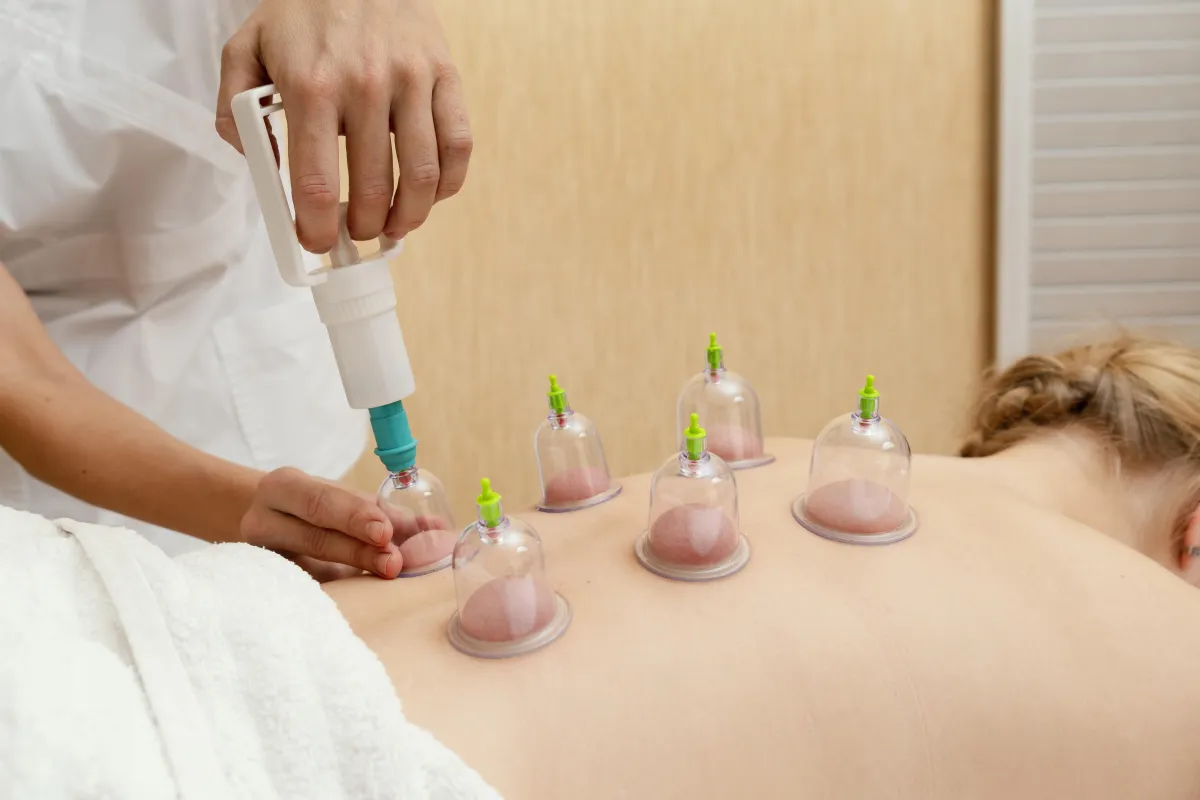Expert Cupping Therapy in NYC
Manhattan Physical Therapy

What is cupping therapy?
Cupping is a hands-on treatment that uses suctioned cups placed on the skin to lift soft tissue, increase local blood flow, and reduce muscle tension. Practitioners use glass, silicone, or plastic cups and create suction either by heat (fire cupping) or mechanical pumps. Sessions vary from gentle gliding (“cupping massage”) to stationary cups that leave temporary, circular marks.
The method has roots in traditional Chinese medicine but is now used across modern sports medicine and rehabilitation settings.
How does cupping work, and what can you expect during a session?
Cupping creates negative pressure that pulls the skin and underlying tissues upward into the cup. That suction increases circulation to the targeted area, stimulates local cellular processes, and can help release tight fascia and trigger points.
Clinically, patients most often report a sense of pressure that quickly becomes relaxing; a session typically lasts 10–20 minutes depending on the goal. Aftercare involves gentle stretching, hydration, and avoiding heavy exertion for the rest of the day.
Who is most likely to benefit from cupping therapy?
People with persistent muscle tightness, chronic or recurring musculoskeletal pain (for example low back, neck, or shoulder pain), and athletes seeking faster recovery commonly choose cupping as an adjunct to physical therapy. Evidence from systematic reviews suggests cupping can reduce pain intensity and improve function for certain chronic pain conditions when combined with standard treatments — although the strength of evidence ranges from low to moderate depending on the condition and study quality. Cupping therapy can relieve muscle tension, and when paired with our sciatica treatment plan, helps reduce nerve-irritation symptoms more effectively.
Practically, cupping is often helpful when tight tissue, poor local circulation, or stuck fascial layers are contributing to limited mobility or ongoing soreness. Your therapist will recommend a tailored plan that combines cupping with movement, manual therapy, and exercise when appropriate.
When should you avoid cupping or use caution?
Cupping is not suitable for everyone. Avoid or use extra caution with active skin infections, open wounds, deep vein thrombosis, severe varicose veins, bleeding disorders, or while taking strong blood thinners. Pregnant people should avoid cupping on the abdomen and lower back. “Wet cupping” (where superficial skin incisions are made) carries higher infection risk and should only be performed by highly trained clinicians in an appropriate medical setting. When applied appropriately, cupping therapy can relieve muscle tension and, when paired with our sciatica treatment plan, helps reduce nerve-irritation symptoms more effectively.
Common, mild side effects include bruising, temporary soreness, or lightheadedness; serious complications are rare when the procedure is performed by qualified providers. Always disclose your full medical history and medications before treatment so clinicians can choose the safest approach.
Where is cupping applied on the body?
Cupping therapy can be applied to many regions, depending on where pain or tightness occurs. The most common areas include the back, shoulders, neck, and thighs — regions that often develop muscle tension from posture, stress, or repetitive movement. In physical therapy settings, cups may also be used on smaller joints such as the knees or ankles to ease stiffness and improve range of motion.
During treatment, your therapist will determine precise placement based on your symptoms and movement patterns. For example, cupping around the shoulder blade area may relieve tension from rotator cuff strain, while cupping on the lower back can help with muscle fatigue and stiffness. The goal isn’t only to relieve symptoms but to restore balance to the surrounding tissues, helping your body move more freely and efficiently.
Why combine cupping with physical therapy?
While cupping alone can provide relief, combining it with physical therapy delivers longer-lasting results. The suction from cupping helps loosen tight fascia and muscle tissue, making it easier to perform corrective exercises afterward. Once the muscles are relaxed and circulation improves, stretching and strengthening movements become more effective.
What conditions can cupping therapy help with?
Cupping therapy is commonly used for a wide range of musculoskeletal and orthopedic conditions. These include:
Chronic back and neck pain: Cupping can relax deep muscle layers, easing tension from prolonged sitting or repetitive strain.
Shoulder impingement or rotator cuff injuries: It helps release muscle knots and improve flexibility in the shoulder complex.
Knee pain and tightness: Often used alongside strengthening and manual therapy to reduce swelling and enhance mobility.
Plantar fasciitis: Cups can be applied to the calf and foot muscles to relieve strain on the plantar fascia.
Sports recovery: Athletes use cupping to decrease soreness, improve blood flow, and speed up post-workout recovery.
Myofascial pain syndrome: Cupping lifts the fascia, reducing adhesions that limit motion and cause discomfort.
Where can you get professional cupping therapy in NYC?
Finding a qualified provider is essential for both safety and effectiveness. At Manhattan Physical Therapy, licensed therapists integrate evidence-based cupping techniques into personalized treatment programs. Each session begins with a detailed evaluation to determine whether cupping is appropriate for your condition.
Unlike spa-based cupping, clinical cupping focuses on specific muscular and functional goals — not just relaxation. The therapists use sterile equipment, controlled suction levels, and precise placement to ensure each treatment aligns with your therapeutic objectives. Patients often report improved range of motion, reduced muscle stiffness, and faster post-exercise recovery after several sessions.
How often should you get cupping therapy?
The ideal frequency depends on your condition and response to treatment. For mild muscle tension or recovery after sports activity, a single weekly session for a few weeks may be sufficient. Chronic pain or long-standing soft tissue restrictions may benefit from multiple sessions spaced one to two weeks apart.
Your therapist will monitor progress and adjust the plan as your pain decreases and movement improves. Over time, you might transition from frequent visits to occasional maintenance sessions to prevent recurrence of tension or stiffness.
What are the proven benefits of cupping therapy?
Modern research continues to validate many of the benefits traditionally associated with cupping. Studies show measurable improvements in pain levels, circulation, and tissue recovery. The therapy’s effects include:
Pain reduction
Enhanced mobility
Faster recovery
Improved circulation
Stress relief
What to expect after your session
After cupping therapy, you may feel lightness or warmth in the treated area, signaling improved blood flow. Mild circular marks or tenderness can occur but usually fade within a few days. Your therapist may recommend gentle stretches or hydration to enhance recovery.
If you experience soreness similar to post-exercise fatigue, that’s a normal part of tissue release. Over the next several sessions, these sensations typically diminish as your muscles adapt and circulation improves.
To schedule your personalized session or learn more about how cupping can support your recovery, call (212)-213-3480 today.
Frequently Asked Questions
Question 1: Is cupping therapy painful?
Cupping isn’t typically painful. You may feel mild pressure or tightness when the suction is applied, but most people describe the sensation as relaxing. The circular marks left on the skin aren’t bruises — they’re a normal sign of increased blood flow and usually fade within a week.
Question 2: How long does a cupping therapy session last?
A typical session lasts about 15 to 30 minutes, depending on the treatment goals and the number of areas being targeted. Some sessions may also include stretching or light massage to enhance results.
Question 3: How many sessions do I need to see results?
Results vary by individual and condition. Many patients notice an improvement after the first or second session, but chronic conditions may require multiple visits. Your therapist will design a plan tailored to your needs and track progress along the way.
Question 4: Can cupping help with sports injuries?
Absolutely. Athletes use cupping therapy to recover faster from training and to prevent muscle overuse injuries. It helps flush out lactic acid, reduce soreness, and improve flexibility — making it a great addition to any sports recovery program.
What Do They Say About Us?
Alexander Liu
"Everyone on the team at Manhattan Physical Therapy is super nice and caring. They were able to pretty quickly diagnose my knee and hip problems and immediately put me to work to reduce the pain.."
Henry Myerberg
"You're not just a patient when you come to the Manhattan Physical Therapy. You feel like family there. In particular, Erica with her colleagues John, Lidia and Joe not only fix and improve you physically, they make you feel welcomed and cared for.."
Hakyung Kim
"Everyone is so kind and helpful! my knee and hip pain have improved massively since starting Manhattan PT, highly recommend to anyone. special thanks to Bianca, Lidia, Joe, and John!"
Manhattan Physical Therapy
✆ Phone (appointments):
(212) 213-3480
Address: 385 5th Ave, Suite 503, New York, NY 10016

